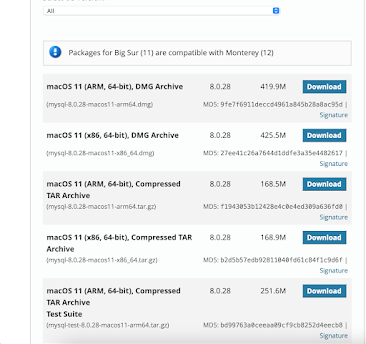About MySQL
MySQL is one of the most popular DBMS software currently. MySQL is developed by "Oracle Corporation" and released in 1995. The founder of MySQL is Michael Widenius. "My" is Michael's Daughter's name. So, My + Structured Query Language = MySQL. MySQL is an open-source database management system.
What is Database?
A database is a collection of data stored in a format that can be easily accessed. In order to database we use a software database management system(DBMS). We connect to a DBMS and give instructions for modifying data. DBMS executes our instruction and gives the result.
There are many DBMS software is there but the most popular software now a day is MySQL by oracle. Basically, MySQL is open source software where you can store your data and perform various actions.
How to install MySQL in MAC?
- First of all, we need to download MySQL.
- Download the software which is compatible with your system.
- Here you can see the login or Sign up. If you want to log in or sign up then go ahead if you don't. Then click on "No thanks Just start download".
- After downloading just double-click on MySQL.
- Now you can see the Introduction tab. Just continue again you see some license agreement and some more formality. Just continue and install it.
- After installation, you have to set a password for MySQL. Remember once you forget this password you have to uninstall MySQL and install it again. So, try not to forget this password.
- Just click on next and set the password and click on finish.
- After installation is done. Go to system preference.
- Now here you can see MySQL. If it is showing then it means you install MySQL.
- Go to your terminal.
- Here you have to give the path of your MySQL server. Now, how do you get the path?
- Go to system preferences and click on MySQL. Right side you can see the path of your MySQL.

- Just copy this path and paste it into your terminal.
- Give the path and hit Enter.
- Then type "./mysql -u root -p" and hit enter.
- Now here enter the password of MySQL you have given while installation.
- Here you are now in MySQL.
- Now create the database.
- First of all, you need to download MySQL.
- Now go to your download folder and double click and install it.
- Here you will see the choosing setup wizard.
- You can manually install it or just select default and click on next.
- Once you click on the Next Button it will check the requirement and lack of requirements. You can fix them by clicking on Execute or skip by clicking on the Next button.
- Now all the required products will install automatically like MySQL server, MySQL workbench, MySQL shell, and many more. It will take some time to install all of them.
- Once it is done click on the Next button.
- Now here you can see the product configuration. Just click on the Next button.
- As soon as you click on n next button it will show you High availability. Select standalone and click on next.
- On the next screen, you will see Config type and connectivity. Just leave it as it is and click on the Next button.
- Now the main part of the MySQL Authentication method. Simply select the first option and give a strong password. (Remember the password which you are giving. If you once forget the password you need to uninstall MySQL and reinstall it.)
- Once you set the password click on the Next button.
- Now you will see some windows services screen simply click on next.
- And now Apply configuration screen just read it and click on Execute and Finish.
- After this, you just need to click on the next button.
- Again you will see Router configuration then connect server screen you just need to give your MySQL password and check it then click on next.
- In the next wizard, you have to select the applied configuration Execute it and click on finish.
- Go to your Start icon and here search for MySQL Command Line Client. Open it.
- Once your MySQL command is opened. Here you need to give the password to which you have given the password while installing.
- Give the password and hit Enter.
- Now you can create your database.
















.png)





%20-%20Copy%20-%20Copy.png)
%20-%20Copy.png)












No comments:
Post a Comment